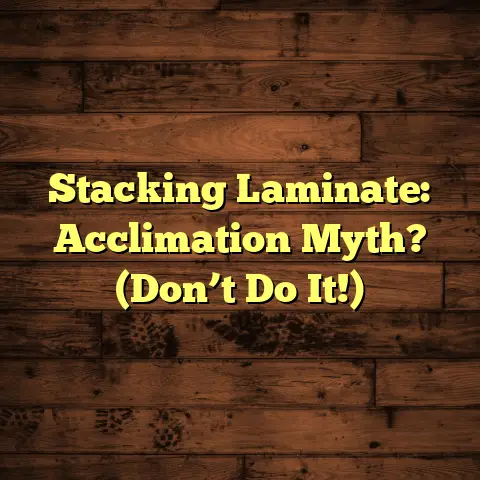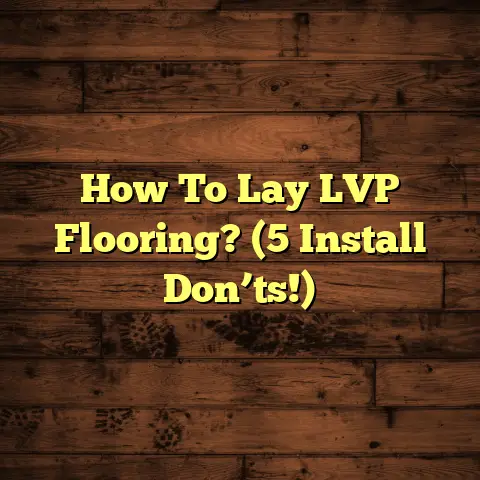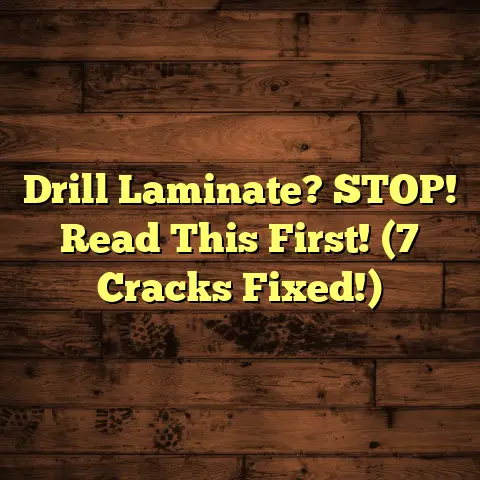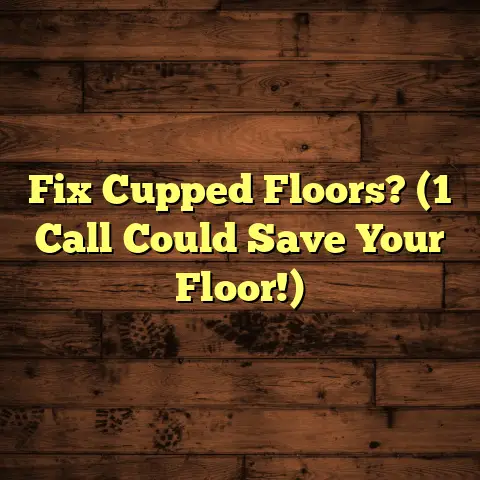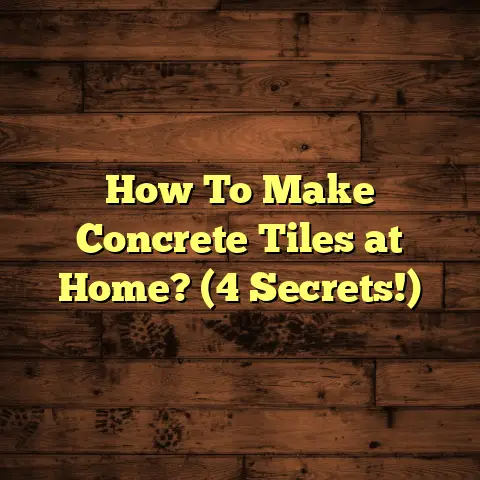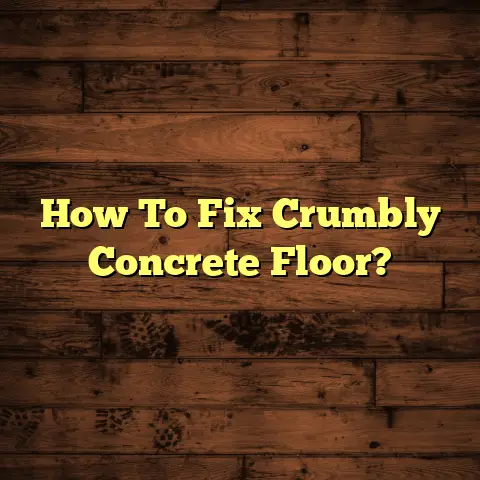Will Sunlight Fade Hardwood? (7 UV Fixes!)
As a flooring contractor with years of experience, I can tell you there’s nothing quite like the warmth and elegance of hardwood floors.
They add a touch of class to any home, boosting its value and making it a more inviting space.
But let’s face it, sunlight, that glorious, life- giving energy source, can also be a bit of a villain when it comes to your precious hardwood.
Have you ever noticed how some areas of your floor, especially those near windows, seem a little lighter or different in color than others?
That’s the sun’s UV rays doing their thing, and understanding how to combat this is crucial for keeping your floors looking their best.
Think of it this way: you wouldn’t go to the beach without sunscreen, right?
Your hardwood floors need protection too!
In this article, I’m going to walk you through everything you need to know about sunlight and hardwood, from understanding why it fades to practical fixes you can implement today.
Let’s dive in and keep those floors looking as stunning as the day they were installed!
Section 1: Understanding Hardwood and Its Vulnerability to Sunlight
So, what makes hardwood so susceptible to fading in the first place?
Well, it all comes down to its composition.
Hardwood, being a natural material, contains pigments that give it its beautiful color.
These pigments, along with the finish applied to protect the wood, are vulnerable to ultraviolet (UV) rays from sunlight.
Think of UV rays as tiny, energetic particles that break down the chemical bonds in these pigments and finishes.
It’s like how prolonged sun exposure can fade the color of your favorite shirt or the paint on your car.
The same principle applies to your hardwood floors.
Now, not all hardwoods are created equal.
Some species are naturally more resistant to fading than others.
For example, denser hardwoods like Brazilian Cherry (Jatoba) tend to be more resistant compared to lighter woods like American Cherry.
This is because denser woods often have more natural oils and extractives that offer some level of UV protection.
Here’s a quick breakdown:
- Lighter Woods (e.g., Maple, Ash): Generally fade faster due to lower density and less natural UV protection.
- Medium Woods (e.g., Red Oak, White Oak): Offer moderate resistance, but still require protection.
- Denser Woods (e.g., Brazilian Cherry, Ipe): Naturally more resistant, but not immune to fading over time.
The finish on your floor also plays a significant role.
Some finishes, like water-based polyurethanes, may offer less UV protection compared to oil-based or ceramic-reinforced finishes.
I’ve seen firsthand how a floor with a cheap, water-based finish fades dramatically faster than one with a high-quality, UV-resistant finish.
To illustrate the process, imagine a simple diagram:
- Sunlight (UV Rays) -> Floor Surface (Finish & Pigments) -> Chemical Bonds Break Down -> Fading & Discoloration
It’s a constant battle, but understanding the enemy—UV rays—is the first step in protecting your floors!
Section 2: Signs of Fading and Damage
Okay, so how do you know if your hardwood floors are actually experiencing UV damage?
Keep an eye out for these telltale signs:
- Color Changes: This is the most obvious sign.
You might notice that areas exposed to direct sunlight are lighter, yellower, or even bleached compared to areas under rugs or furniture. - Loss of Luster: The finish on your floor might appear dull or faded, losing its original shine.
- Uneven Appearance: You’ll see distinct differences in color and tone between sunny and shaded areas, creating an inconsistent look.
- Cracking or Warping: In severe cases, prolonged UV exposure can dry out the wood, leading to cracks or warping, especially near windows.
I remember one client who called me in a panic because their beautiful cherry floors had turned almost orange in some spots.
They had large, south-facing windows with no window treatments, and the sun had wreaked havoc.
The difference between the exposed and covered areas was stark.
To assess your own floors, try this:
- Compare Areas: Lift up a rug or move a piece of furniture that’s been in the same spot for a while.
Observe the color difference between the covered and exposed areas. - Check Near Windows: Pay close attention to the flooring near windows, especially those that receive direct sunlight for several hours a day.
- Look for Dullness: Examine the finish in high-traffic areas versus low-traffic areas.
Is the finish still glossy, or does it look worn and faded?
Don’t just take my word for it.
I spoke with Sarah Johnson, a certified flooring
inspector with over 20 years of experience, and she
emphasized, “Early detection is key.
The sooner you
notice fading, the easier it is to address the
problem.
Regular inspections and proactive measures
can save you a lot of time and money in the long run.”
Here’s a quick checklist to help you identify fading:
If you spot any of these signs, don’t panic!
It’s a common issue, and there are plenty of steps you can take to mitigate the damage and prevent further fading.
Section 3: The Importance of Preventative Measures
Now that we’ve established that sunlight can indeed fade hardwood, let’s talk about why preventative measures are so crucial.
Think of your hardwood floors as an investment.
A well-maintained hardwood floor can last for decades, adding significant value to your home.
Neglecting them, however, can lead to costly repairs or even complete replacement.
According to the National Wood Flooring Association (NWFA), the average cost of installing new hardwood flooring ranges from $8 to $25 per square foot, depending on the type of wood and installation method.
Let’s say you have 500 square feet of hardwood
flooring.
Replacing it could cost you anywhere from
$4,000 to $12,500!
On the other hand, investing in preventative measures like UV-blocking window treatments or regular maintenance can cost a fraction of that amount.
For example, high-quality UV-blocking window film might cost around $3 to $7 per square foot, and a professional floor refinishing job might cost $3 to $8 per square foot.
Even if you implement multiple preventative measures, you’ll likely spend far less than the cost of replacing your floors.
Here’s a simple comparison:
Moreover, prevention is not just about saving money.
It’s also about preserving the beauty and integrity of your home.
Faded, damaged floors can detract from the overall aesthetic appeal of your living space, making it look dated and uninviting.
A well-maintained hardwood floor, on the other hand, adds warmth, character, and a touch of luxury to your home.
I’ve seen firsthand how a simple floor refinishing can completely transform a room, breathing new life into the space.
Don’t wait until the damage is done.
Take proactive steps to protect your hardwood floors from the sun’s harmful UV rays, and you’ll enjoy their beauty and value for years to come.
Section 4: 7 UV Fixes for Fading Hardwood Flooring
Alright, let’s get down to the nitty-gritty.
Here are seven actionable fixes you can implement to combat UV-related fading of your hardwood floors:
1. UV-Blocking Window Treatments
This is your first line of defense!
UV-blocking window treatments can significantly reduce the amount of UV radiation that enters your home.
Here are a few options to consider:
- UV-Blocking Window Film: This is a thin, transparent film that you apply directly to your windows.
It blocks up to 99% of UV rays without significantly reducing visible light.
It’s a relatively affordable and effective solution. - Solar Shades: These shades are designed to filter out sunlight while maintaining your view.
They come in various densities, allowing you to control the amount of light and UV radiation that enters your home. - Blackout Curtains: While they might not be ideal for every room, blackout curtains are incredibly effective at blocking out all light, including UV rays.
They’re great for bedrooms or media rooms. - Plantation Shutters: These stylish shutters not only add a touch of elegance to your home but also provide excellent UV protection.
You can adjust the louvers to control the amount of light and UV radiation that enters the room.
I personally recommend UV-blocking window film for its affordability and ease of installation.
You can even find DIY kits online and apply it yourself.
Just make sure to clean your windows thoroughly before applying the film to avoid bubbles or imperfections.
2. Strategic Furniture Placement
This one’s simple but surprisingly effective.
Rearranging your furniture can provide natural shade and protect high-exposure areas from direct sunlight.
Think about it: if you have a large sofa or bookshelf, position it in a way that blocks sunlight from hitting the most vulnerable areas of your floor.
For example, if you have a south-facing window that receives a lot of direct sunlight, place a tall bookshelf or a large plant in front of it to cast a shadow on the floor.
You can also rotate your rugs periodically to ensure even wear and prevent one area from fading more than others.
It’s like giving your floor a little vacation from the sun!
3. Area Rugs and Mats
Area rugs are not just decorative; they’re also powerful UV shields!
Placing area rugs in high-traffic areas or in areas that receive a lot of direct sunlight can significantly reduce UV exposure.
Choose rugs made from natural fibers like wool or cotton, as they tend to be more durable and resistant to fading themselves.
You can also use mats near doorways to prevent dirt and grit from scratching the finish on your floors, further protecting them from damage.
I always advise my clients to choose rugs that complement their decor while also providing adequate coverage.
A large area rug can cover a significant portion of the floor, shielding it from UV rays and adding a touch of style to your home.
4. Regular Maintenance and Refinishing
Think of your floor’s finish as its sunscreen.
Regular maintenance is essential to keep that sunscreen working effectively.
Here’s what you should do:
- Regular Cleaning: Sweep or vacuum your floors regularly to remove dirt and debris that can scratch the finish.
- Gentle Cleaning Products: Use cleaning products specifically designed for hardwood floors.
Avoid harsh chemicals or abrasive cleaners that can damage the finish. - Professional Refinishing: Every few years, consider having your floors professionally refinished.
This involves sanding down the old finish and applying a new coat of sealant, restoring the floor’s luster and providing a fresh layer of UV protection.
Refinishing is like giving your floors a complete makeover.
It not only removes scratches and imperfections but also allows you to choose a new finish with enhanced UV protection.
5. UV-Resistant Floor Finishes
Speaking of finishes, did you know that some finishes offer better UV protection than others?
When refinishing your floors, ask your contractor about UV-resistant finishes.
These finishes contain additives that help block UV rays, preventing them from damaging the wood beneath.
Here are a few types of UV-resistant finishes to consider:
- Oil-Based Polyurethane: Offers good durability and UV protection.
It tends to yellow over time, which can enhance the warmth of the wood. - Water-Based Polyurethane: Provides excellent clarity and UV protection.
It doesn’t yellow as much as oil-based polyurethane, making it a good choice for lighter woods. - Ceramic-Reinforced Finishes: These finishes are incredibly durable and offer superior UV protection.
They’re more expensive than traditional polyurethanes but can last for many years.
I’ve had great success with ceramic-reinforced finishes.
They’re incredibly tough and resistant to scratches, stains, and UV fading.
They’re a bit of an investment upfront, but they’ll save you money in the long run by extending the life of your floors.
6. Plant Placement
Bring the outdoors in, and protect your floors at the same time!
Strategically placing indoor plants can not only beautify your space but also provide shade and reduce light intensity.
Tall, leafy plants can act as natural sunscreens, blocking direct sunlight from hitting your floors.
Consider placing plants near windows or in areas that receive a lot of direct sunlight.
Not only will your floors thank you, but your plants will thrive in the sunlight!
7. Use of Sunlight-Reflecting Decor
Finally, consider using lighter-colored decor and furnishings that reflect sunlight rather than absorb it.
Dark colors absorb more heat and UV radiation, increasing the risk of fading.
Lighter colors, on the other hand, reflect sunlight, helping to minimize heat and UV penetration.
Choose light-colored walls, furniture, and accessories to create a brighter, more UV-resistant environment.
It’s a subtle change, but it can make a big difference in the long run.
Section 5: Conclusion
So, there you have it!
Seven actionable fixes to protect your hardwood floors from the sun’s harmful UV rays.
Remember, being proactive is key to maintaining the beauty and durability of your hardwood floors.
By implementing these solutions, you can significantly reduce the risk of fading and keep your floors looking their best for years to come.
To recap, here are the seven UV fixes we discussed:
- UV-Blocking Window Treatments
- Strategic Furniture Placement
- Area Rugs and Mats
- Regular Maintenance and Refinishing
- UV-Resistant Floor Finishes
- Plant Placement
- Use of Sunlight-Reflecting Decor
I encourage you to implement these solutions in your own home and see the difference they can make.
Don’t be afraid to experiment and find what works best for your specific needs and preferences.
And remember, if you’re ever unsure about anything, don’t hesitate to consult with a professional flooring contractor.
We’re here to help you keep your floors looking their best!
Now, I’d love to hear from you.
What are your experiences with hardwood floor fading?
Have you tried any of these solutions?
Do you have any additional tips or tricks to share?
Leave a comment below and let’s start a conversation!
Together, we can help each other preserve the beauty and value of our hardwood floors for generations to come.
